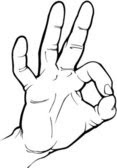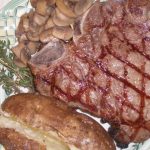Don’t have a meat thermometer and need a way to know just the right time to pull the steaks off the grill? Use this simple BBQ Trick that we call the OK Handy method for using the ball of your thumb to determine if your BBQ meat is Rare/ Medium / or Well Done. It’s easy… plus how to use a toothpick to test the doneness of ribs. More on the tip HERE or watch the video here.
Temperature
Steak Done? An OK Handy Method
If you like your steak Well-Done (like me) or Rare (like many) the fool proof way to know “when it’s done” is use a dependable instant read thermometer. After reading this you’ll probably be frustrated until you get one. Here’s some recommended beef “doneness” temperatures:
Blue rare 120°F
Rare 125 to 130°F
Medium-rare 130 to 135°F
Medium 135 to 145°F
Medium-well 145 to 150°F
Well-done 150 to 155°F
Really well done 160°F plus
Bookmark our: Temperature Guide
So… what if you forgot the handy meat thermometer? There’s a handy barbecue tip that’s been around a long time. “Hand”-y as in Hand. You can test your steak’s done-ness using the OK handy method. It’s easy. Massage, stretch, and shake one hand loose so that your thumb and it’s muscles are fully relaxed.
Touch the round base of your thumb on the relaxed hand. This soft resistance and feel is similar to the texture of a very rare thick steak.
 Now – make the “OK” sign (don’t pinch… just close your thumb and forefinger together) and again touch the base of your thumb. This texture is similar to a medium-rare steak.
Now – make the “OK” sign (don’t pinch… just close your thumb and forefinger together) and again touch the base of your thumb. This texture is similar to a medium-rare steak.
Next, touch your thumb to your middle finger. This firmer resistance is similar to the texture of a medium steak.
Press your thumb to your fourth finger. The semi-firm texture at the base of your thumb is similar to a medium-well steak.
Finally, touch your thumb to your pinky. The very firm (some would say tough) texture at the base of your thumb is close to a well-done steak.
Poultry’s Recommended Internal Temperature: Is It Done yet?
Looking to safely cook chicken or turkey, without having it come out dry and flavorless? The USDA says to cook until the juices of the wings and thighs run clear. The only way to do it is use a thermometer (see below), and remember the wings and thighs reach a higher temperature faster than the breast. Here are some simple guidelines for safe internal temperatures that will keep your poultry tasting great! All measurements are Fahrenheit.
- Ground Chicken or Turkey 165 degrees
- Whole Chicken or Turkey 180 degrees (thighs, wings & legs) / 160 – 165 degrees (breast) Note: This should occur at about the same time.
- Chicken or Turkey Breast 170 degrees
- Duck 180 degrees
- Grilled or Roasted Quail 145 degrees
In general, The USDA suggests poultry be cooked to an internal temperature of 165 before serving. This is lowered from a pre-2006 recommendation of 180 for turkey. Many of us have become too dependant on the “factory installed” thermometer that comes in frozen birds these days. These are likely to err on the side of “over cooked.”
It is important to remember that internal temperature will indeed rise a bit while “resting” off the grill.
One universal tip is to watch for the juices to run clear but the best way to really know is by using an accurate instant read thermometer. You may already have an old dial faced version in your gadget drawer. In theory these are just fine and worked for many years; however I almost always find myself questioning the results. We prefer some of the really good digital instant read thermometer now available. In less than ten seconds you’ll really know what temperature you have.
 Cooks Illustrated spends a lot of time researching and testing the best of the best and when it comes to thermometers they suggest a model made by Thermapen for about $80 (based on pin-point accuracy and quick respnse time). But there are a few less expensive models.
Cooks Illustrated spends a lot of time researching and testing the best of the best and when it comes to thermometers they suggest a model made by Thermapen for about $80 (based on pin-point accuracy and quick respnse time). But there are a few less expensive models.
NOTE: If the thermometer you’re using needs to be “converted” from Fahrenheit to Celsius use this formula: Subtract 32 degrees from the (Fahrenheit) reading, then divide that number by 1.8. The result is the Celsius.


